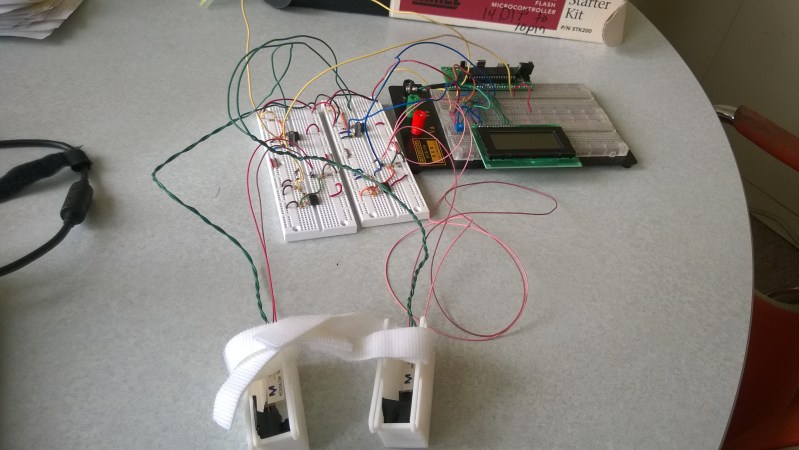The students over at Cornell’s School of Electrical and Computer Engineering have been hard at it again with their senior projects. This time, it’s the very tiny and portable drumset dubbed Drums Anywhere by its creators [Shiva Rajagopal] and [Richard Quan]. Since there are other highly portable instruments like roll-up pianos, they suppose there should be a portable drum kit that actually sounds like drums, and this ECE duo have hit the metaphorical and physical drum on the head… except that this project doesn’t actually use physical drums to make sound.
The project consists of two 3D-printed box-like sensors with velcro straps that can be attached to any drumstick-shaped object that might be lying around. Inside the box is a flex sensor and a tiny microphone which report the “beats” to a microcontroller when they strike another object.
On the software side, there are two sampled sounds stored in the microcontroller but they plan to add more sounds in the future. The microcontroller outputs sound to a pair of speakers, and the sensors are sensitive to force, so the volume can range from almost inaudible all the way up to [John Bonham]-style booms. This could also be theoretically expanded to include more than two “beat boxes” for extra sounds, or be wireless. The options are virtually limitless, although the team notes that they are limited by the number of interrupts and ADC converters on their particular microcontroller, an ATmega1284.
This is another interesting take on a having drumset without the drums, and definitely expands the range of what a virtual drum set can do. It’s also great to see interesting projects coming from senior design classes! Be sure to check out the video after the break.

















http://www.drumsanywhere.com
50% OFF!? whats half of 49.99? is is 29.99? actually no it’s not…
Now it says $24.99, so I guess they fixed that.
Or the precursor, http://en.wikipedia.org/wiki/Hit_Stix
Or the more expensive http://aerodrums.com/aerodrums/
DrumsAnywhere is the closest solution to real drumming. Aerodrums does not give you the real feel of playing drums. HitStix is merely a toy.
You obviously have never seen Aerodrums.
I am not that convinced that – aside from the “fun” side of the project – the two guys understand what playing drums is about …. a real drum gives different sounds not only depending on “how hard you hit it”, but also depending on WHERE you hit it (crashs/cymbals, snares, toms … they all give a variety of sounds).
Well, ok, “fun” is good of course … but “drums” anywhere seems a bit far fetched for what you can do with that setup.
how about putting gyros in and depending on angle of attack you have have different sounds. higher more angled “hit” on the accelerometers and you got a cymbal.
Seeing this gave me a flashback to the 80s. I remember a portable drum kit that does pretty much the same thing, only that it resembled drumsticks. The only upside to this project that I see is being able to swap out samples.
http://en.wikipedia.org/wiki/Hit_Stix
Everything old is new again. ;)
So they’re re-creating a toy from the 90’s?
http://retrothing.typepad.com/photos/uncategorized/hitstix_01_1.jpg
My apologies. I had the page loaded at work and didn’t see someone beat me to posting the Hit Stix comment.
Definitely a rehash of an old product, but I like the simple nature and extensibility. It has a lot more potential than these guys put in this revision. I can see additions for a foot pedal easily added.
To me, they seem to be concurrently translating vibrational timing cues (by “floating” a flex sensor), and vibrational energy (amplitude- by microphone). Correct me if I’m wrong, but couldn’t you get both of those variables with a piezo sensor, vastly simplifying the build? As they’re only using the amplitude of the mic inside the box- which is mechanically connected to the source of vibration- they’re only receiving data re: force. The flex sensor sensing impact, and a microphone sensing force seem a little overkill to me. (You could even use an array of smaller piezos, incorporating them into a heavy sticker, making a thin, conformable, stick-on impact sensor, or stick a few in different places on the stick, giving different data for different types of hits. Or stick 3-10 of them on varied objects, instantly creating a drumkit). Maybe I’m off-base. (off beat? lol)
Either they learned their lesson or they took your advice – their DrumsAnywhere kit only requires a contact microphone now.
I see nothing wrong with Drumanywhere copying or improving an old idea with some new features, especially cosidering the personal devices the SW could be run on not available in the 90’s. It appears these young innovators are listening to the feedback from real drummer / musicians, so I’m looking forward to their 2.0 and beyond. I operate a small home studio and my percussion needs are modest and simple and this uses only the amount of surface area I have to give it. Nicely done!